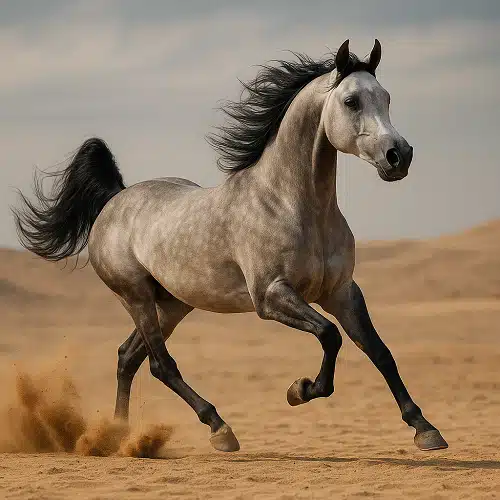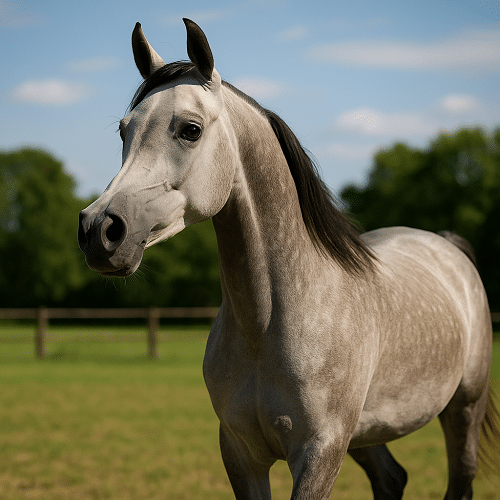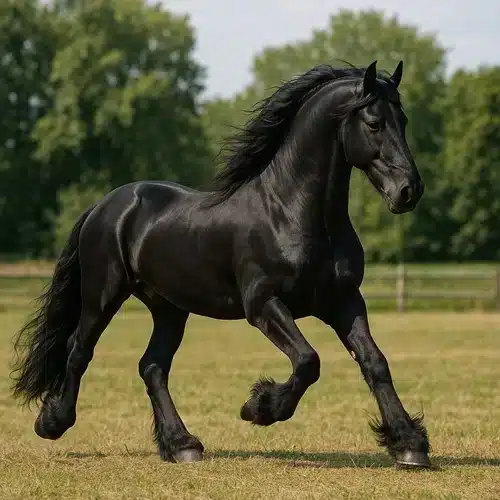The Arabian horse is one of the oldest and most noble horse breeds in the world. Originating from the Arabian Peninsula, it has accompanied Bedouins for centuries. As a purebred Arabian, it represents the essence of equine beauty and a symbol of endurance. This horse is not only elegant and spirited, but also intelligent and deeply attached to humans. In this article, we explore the history, physical traits, character, and the role of Arabian horses in modern equestrianism.
Contents
Origin and History of the Arabian Horse
The Arabian horse, also known as the purebred Arabian, is one of the most recognizable and revered horse breeds in the world. Its slender silhouette, distinctive refined head, high-set tail, and exceptional intelligence have earned it the status of a living legend over the centuries. This breed has played a significant role not only in the history of civilization but also in shaping many other utility and sport horse breeds.
The origins of the Arabian horse date back to antiquity—it’s said that over 4,000 years ago, they inhabited the Arabian Peninsula, where they served not only as a means of transport but also as indispensable companions to nomadic Bedouin tribes. These horses were not treated as ordinary animals—they were considered part of the family. They slept inside tents with people, shared food and water, and their courage in battle often determined the fate of entire tribes.
For centuries, the purity of their bloodlines was strictly protected. Breeding was based on careful selection—not only in terms of physical appearance but also temperament. Thanks to this, Arabian horses have preserved their unique conformation, as well as extraordinary endurance, loyalty, and a remarkable ability to work with humans. Over time, they were introduced to Europe and the Americas, where they played a vital role in improving local breeds—such as Anglo-Arabians, Thoroughbreds, and Trakehners.
Today, the Arabian horse still holds a special status. It is a symbol of elegance, intelligence, and resilience. Its presence at purebred Arabian horse shows draws crowds, while athletes value its phenomenal stamina, especially in long-distance endurance riding. The breed also has an important place in recreational riding—more and more equestrian enthusiasts choose Arabians as their partners due to their sensitivity, affection, and spirited nature.
Arabian horses are now bred all over the world—from desert studs in the Middle East, through legendary Polish breeding centers like Janów Podlaski and Michałów, to modern farms in the USA, Brazil, and Australia. Wherever they go, they captivate and inspire. This is a breed that has not only stood the test of time but continues to write its story—with grace, strength, and heart.
Appearance and Distinctive Features – The Arabian Horse
Skeletal Anatomy – Unique Number of Ribs and “Dry Bone” Structure
One of the most remarkable features of the Arabian horse is its distinctive skeletal structure. While most horse breeds have 18 pairs of ribs, 6 lumbar vertebrae, and 18 tail vertebrae, the Arabian horse typically has 17 pairs of ribs, 5 lumbar vertebrae, and 16 tail vertebrae. Although these differences may seem minor, they have a significant impact on the horse’s overall build and movement.
Fewer ribs and vertebrae result in a shorter back, which translates to greater agility and ease in carrying a rider. This makes Arabian horses particularly comfortable under the saddle, especially for leisure or long-distance riding. Their body is compact and harmonious, with slim yet strong limbs, clearly defined joints, and tendons.
The term “dry bone” refers to their very lean and refined body structure—without excessive fat or heavy musculature. As a result, Arabian horses appear delicate yet powerful and enduring. Prominent veins, a fine head, and a light build are not only desirable traits in show breeding but also practical advantages in everyday riding.
We invite you to read the article: The Akhal-Teke Horse – The Golden Warrior from Turkmenistan – Through life on horseback
Profile, Neck, Tail – Impact on Movement and Balance
The head of the Arabian horse is its most iconic feature. It is defined by a concave profile, known as a “dished face”—a gently sunken line from forehead to muzzle. This characteristic gives the horse a unique, almost mythical appearance, complemented by large eyes, wide nostrils, and a short muzzle. These features are not only visually striking but also functional—they enhance airflow and breathing efficiency during intense physical exertion.
The neck is long, arched, high-set, and flexible. This is more than just a matter of beauty—a well-shaped neck plays a crucial role in the horse’s balance and aids in communication with the rider, especially in dressage and showmanship. Another signature trait of Arabian horses is their high-set tail, which is carried vertically when the horse is galloping or excited. This striking tail carriage symbolizes pride and vitality and is one of the most admired traits in halter show competitions.

Coat Colors, Pigmentation, and Genetic Curiosities
Arabian horses most commonly appear in grey, bay, chestnut, dark bay (seal brown), and roan coat colors. Grey is particularly dominant in many show lines and has a unique trait—it lightens with age. A foal may be born dark and gradually turn nearly white over the years. This process is driven by the G (gray) gene, which is responsible for the progressive “whitening” of the coat as the horse matures.
Another distinctive feature of the Arabian horse is its dark skin pigmentation. Even if the coat is grey, the underlying skin remains black, providing natural protection against the sun. This trait is yet another example of the breed’s adaptation to desert climates—dark skin reflects harmful UV rays more effectively, and their dense coat helps protect against dust and insects.
From a genetic standpoint, the Arabian horse is notable for its unique mitochondrial haplotypes, which confirm its ancient origins. DNA studies have shown that many modern horse breeds have Arabian ancestors in their lineage, further highlighting the importance of this breed in the global history of horse breeding.
Show, Race, and Endurance Types – Different Faces of the Arabian Horse
Modern Arabian horse breeding has led to the development of several “subtypes” within the same breed, depending on their primary purpose:
Race Type (Race Arab) – Bred specifically for speed, particularly in Arab countries and France. These horses have a more athletic build—a longer back, stronger limbs, and less extreme facial features. They excel on the racetrack, where Arabian horses have dedicated races such as the Qatar Arabian Trophy.
Show Type (Show Arab) – The most “storybook-like” in appearance, bred with a strong emphasis on beauty and expression. This type features an extremely dished profile, large eyes, a slender arched neck, and flashy movement. Show Arabs are commonly seen in halter competitions and beauty contests, where appearance and presence are the main criteria.
Endurance Type (Endurance Arab) – The most durable, though not necessarily the most aesthetically refined. These horses are built for long-distance riding—lightweight, dry-bodied, with large lung capacity and a low resting heart rate. They dominate endurance competitions covering distances from 80 to 160 kilometers.
Temperament and Personality of the Arabian Horse
Intelligence, Sensitivity, Attachment – The Emotional Nature of the Arabian
For centuries, the Arabian horse has been regarded as one of the most intelligent and emotionally aware horse breeds. It is not just a working animal—it is a partner capable of forming deep bonds with humans. Bedouins used to say that Arabians understand more than words can express and should be treated as members of the family, not merely tools for labor. Today, we know that this breed possesses high emotional sensitivity, excellent memory, and a strong sense of loyalty.
Their intelligence is evident on many levels—they learn new commands quickly, are highly alert, and can solve simple problems on their own. Just a few well-guided training sessions are often enough for an Arabian to master a new task—provided it feels safe and understands what is expected. In interactions with people, they are often described as “intuitive”—able to sense a handler’s mood and adapt their behavior accordingly.
However, it’s important to remember that this intelligence comes with heightened emotional sensitivity. Arabian horses can become stressed if training is too intense, chaotic, or if they are treated harshly. A single negative experience—such as rough handling—can stay in their memory for a long time and require patience and effort to rebuild trust.
Typical Reactions to Training and Matching Rider Types
Arabian horses are naturally very quick learners, but they require clear boundaries, consistency, and a gentle approach. They respond exceptionally well to positive training methods—such as treat rewards or verbal praise—and tend to learn much better through relationship-building than through force. Many trainers note that working with an Arabian feels more like a dialogue—you can’t “break” them, but you can earn their trust and cooperation.
Typical training responses in Arabians include:
- Quick reactions to stimuli
- Strong memory, including remembering trainer errors
- Withdrawal or nervousness under pressure
- Excitement in new environments or unfamiliar situations
Because of these traits, Arabians thrive best with patient, experienced riders who are able to “read” the horse’s emotions. That said, they are not unsuitable for less experienced riders—but beginners should work under the guidance of a trainer familiar with the breed’s unique temperament.
Ideal Rider Profiles – Is the Arabian Horse a Good Match?
| Rider Type | Is the Arabian Horse Suitable? | Notes |
|---|---|---|
| Beginner Adult | ⚠️ Rather not for a start | Better under the supervision of an experienced instructor |
| Experienced Child | ✅ Yes | Arabians are often used in children’s recreational riding |
| Advanced Rider | ✅ Absolutely | An ideal breed for developing a deep bond and refining riding skills |
| Competitive Rider (Dressage, Endurance) | ✅ Depends on the horse type | Excellent for endurance; suitability for dressage depends on build and training |
| Nervous or Impulsive Person | ❌ Definitely not | The horse picks up on emotions and may become anxious or reactive |
Potential Challenges – High Energy and Mental Stimulation Needs
One of the most frequently mentioned traits of Arabian horses is their lively temperament. On the one hand, this makes them energetic and eager to work; on the other, it can present certain challenges. Arabians can become overly excitable, especially if kept in a stall for long periods without adequate movement or stimulation. Boredom and lack of engagement may lead to stereotypic behaviors such as stall walking, chewing on objects, or excessive neighing.
This breed requires not only physical activity but also mental stimulation. Training sessions should be varied—repetitive, monotonous routines can lead to frustration and disengagement. Arabian horses respond particularly well to:
- Groundwork and interaction based on natural horsemanship
- Varied trail riding adventures
- Arena work combined with obstacles or poles
- Social interaction with other horses—they are highly social animals
Another potential challenge is their heightened sensitivity to touch and cues. Arabians often respond to very subtle signals, which can be difficult for novice riders to interpret. However, for experienced equestrians, this sensitivity is a major advantage—it allows for precise, refined communication and a truly responsive partnership.

Utility and Sporting Achievements of Arabian Horses
Endurance – Global Success and Training Specifics
Arabian horses are the undisputed kings of endurance riding—an equestrian discipline that demands not only excellent physical fitness, but also strong mental resilience, metabolic endurance, and resistance to fatigue. In endurance, horses cover distances ranging from 40 to even 160 kilometers in a single day, all while maintaining a good health status—assessed at veterinary checkpoints throughout the ride.
The Arabian breed dominates this discipline for several reasons:
- Low resting heart rate and quick recovery after exertion
- Natural stamina and efficient, energy-saving movement
- Light and dry build, preventing overheating during long rides
- Strong motivation and psychological resilience to prolonged effort
Training an Arabian for endurance is a long-term, systematic process. It begins with building a base level of fitness—long, slow trail rides across varied terrain and footing. Later stages introduce interval training, strength exercises, and recovery work. Monitoring the horse’s heart rate, hydration, and muscle condition is crucial throughout the program.
Equally important is proper nutrition. Endurance horses need a balanced diet rich in slow-releasing energy sources (fiber, oils), electrolytes, and antioxidants that support recovery. Before a ride, the horse should be well-hydrated but not overfed. After the race, it’s vital to quickly replenish fluids and electrolytes, provide a light concentrate feed, and allow time for rest and recuperation.
On the international stage, Arabians have earned championship titles in competitions organized by the FEI (Fédération Équestre Internationale). One of the most prestigious endurance events is the HH Sheikh Mohammed Cup in Dubai, where Arabians consistently shine and affirm their global reputation.
We invite you to read the article: The Friesian Horse – Characteristics, History, and Uses of This Majestic Breed – Through life on horseback
Sporting Applications: Dressage, Showing, Recreational Riding
Although Arabian horses are most often associated with endurance, their versatility allows them to excel in a variety of other equestrian disciplines:
- Dressage: While they may not dominate high-level competition, well-trained Arabians can perform beautifully at lower levels, offering expressive movement and responsiveness.
- Halter and Show Classes: Especially bred show-type Arabians are stars in conformation and beauty contests, captivating audiences with their elegance, presence, and movement.
- Recreational Trail Riding: Thanks to their stamina, surefootedness, and intelligence, Arabians make fantastic companions for long, enjoyable trail rides.
- Working Equitation and Liberty Work: Their agility, intuition, and close connection with handlers make them ideal for disciplines that focus on precision, versatility, and trust.
In short, the Arabian horse combines heart, intelligence, and athleticism—making it not only a sport achiever but also a soulful partner for riders across disciplines.
Dressage
Although Arabian horses do not typically dominate classical dressage competitions—mainly due to their build and naturally elastic movement—they are quite successful at amateur and regional levels, as well as in youth rider classes. Their greatest strengths in dressage include:
- Willingness to cooperate
- Flexibility and suppleness in movement
- Striking appearance in the arena
Dressage training with an Arabian requires patience. These horses are intelligent, but they can become bored easily and may become overly excitable if stressed. In return, they offer lightness, expression, and remarkable precision—especially in transitions and half-halts. With the right rider and approach, an Arabian can become a graceful and responsive partner in the dressage arena.
Halter Shows
In purebred Arabian horse shows, horses are judged based on conformation, posture, movement, and expression. The finest Arabians compete in prestigious events such as:
- The Polish National Arabian Horse Championship (Janów Podlaski)
- The Paris World Arabian Horse Championship
- The Scottsdale Arabian Horse Show (USA)
Show horses are often specially prepared for presentation: they are trimmed, trained to pose in the “stand-up” stance, and conditioned using props that stimulate expression (e.g., rattles, umbrellas, sound cues).

Recreational Trail Riding
For amateur riders, Arabian horses are ideal partners for leisure riding and trekking. Thanks to their endurance, smooth gaits, and natural curiosity, they are excellent companions for long hours on the trail. They are also popular in so-called “trekking rallies”, where horse and rider travel dozens of kilometers over several days, camping in forests or staying at agritourism farms.
Care and Needs of Arabian Horses
The Arabian horse is not particularly demanding to keep, but it does require a proper diet and regular exercise. Daily grooming, hoof checks, and consistent training are essential for maintaining its health and well-being. Arabians need access to a paddock and regular interaction with other horses. Being highly social animals, they do not tolerate isolation well.
In an Arabian horse breeding facility, it’s important to care not only for the horse’s body, but also for its mind. Mental stimulation, varied training, and a supportive social environment are key to keeping these intelligent and sensitive horses happy and balanced.
Common Mistakes When Choosing an Arabian Horse
One of the most frequent mistakes is placing an Arabian horse in the hands of a beginner rider. While undeniably beautiful, this breed is not always suitable for those without prior experience. Another common error is buying an Arabian without understanding its specific needs. This breed requires attention, time, and a deep level of understanding.
The Arabian is not your average recreational horse you’d find in a typical classified ad. Choosing an Arabian should be a well-thought-out decision, ideally made in consultation with a reputable breeding farm. Proper guidance ensures both the rider and the horse find a suitable match for a successful partnership.
Famous Arabians – Personal Stories
Throughout history, Arabian horses have left their mark not only in breeding registries and studbooks but also in the annals of world history, military campaigns, and sport. Their exceptional temperament and elegance have made them the companions of powerful figures, and some have become enduring symbols of bravery, endurance, and breeding excellence.
Marengo – Napoleon’s Horse
Marengo was the favorite horse of Napoleon Bonaparte. Brought from Egypt to France in 1799, this purebred Arabian captivated the emperor with his beauty, courage, and unwavering loyalty. Marengo served Napoleon for many years and took part in some of his most significant military campaigns, including Austerlitz, Jena, Wagram, and even the ill-fated Battle of Waterloo.
Remarkably, despite the hardships of war and numerous injuries, Marengo always returned from battle. He was small—standing at only about 145 cm (14.1 hands) at the withers—but made up for it with immense spirit and steadfastness. After Napoleon’s defeat, Marengo was captured by the British and brought to London, where he lived out his days at stud.
Today, his skeleton is displayed at the National Army Museum in London, serving as a symbol of the resilience of Arabian horses and a powerful testament to the deep bond between horse and rider throughout history.
Skowronek – The Horse That Transformed European Breeding
Skowronek, born in Poland in 1909, was an Arabian stallion who revolutionized British and American purebred horse breeding. His dam was a Polish mare from Janów, and his sire, Ibrahim, was of Egyptian origin. Skowronek was later sold to England, where he became part of the famous Crabbet Park Stud, owned by Lady Wentworth.
It was at Crabbet Park that Skowronek began a legacy of producing horses with exceptional conformation and temperament. He possessed a remarkably refined head, expressive eyes, a compact body, and a kind, gentle nature. His offspring were known for their outstanding beauty and consistently won top titles at major shows.
Even more impressively, Skowronek’s genes can be found in the pedigrees of most modern show Arabians. He became a living legend and is now considered one of the most influential stallions of the 20th century. His descendants remain a foundation for many breeding programs in the USA, the UK, and the Middle East.
Witez II – The Miracle Horse of Polish Breeding and War
Witez II is a horse whose life story could easily inspire a Hollywood screenplay. Born in 1938 at the Janów Podlaski Stud in Poland, he was the son of the legendary stallion Ofir and the mare Federacja—both representatives of the golden lineage of Polish Arabian breeding.
The outbreak of World War II cast doubt on the future of many stud farms, including Janów. In 1939, just before the Soviet invasion, the young Witez II was evacuated to Germany along with a group of valuable horses. However, his journey didn’t end there. Recognized for his extraordinary appearance and beauty, he was taken by the Germans and later transported to Czechoslovakia.
In 1945, thanks to American soldiers who recognized the breeding value of the horses, Witez II was rescued and brought to the United States as part of a mission to save Europe’s Arabian bloodlines—known as “Mission Polish Horses.” Once in the U.S., he achieved tremendous success as a breeding stallion. His offspring dominated American show rings for decades.
To this day, Witez II is considered the most famous Polish Arabian in American history, symbolizing not only the excellence of Polish breeding but also the resilience and enduring legacy of the Arabian horse through times of war.
Modern-Day “Celebrities” – Endurance Record-Holders
In the 21st century, the Arabian horse continues to shine—both in show rings and in the world of sport. Today’s Arabians achieve spectacular results in endurance riding, and some have become true “celebrities” in the endurance community.
One standout example is Nobby, a purebred Arabian gelding from France who, alongside rider María Álvarez Pontón, won an astonishing four FEI World Endurance Championship titles. This legendary pair was nearly unbeatable for years. Nobby was known for his incredible speed, excellent health, and unwavering mental stability.
Another well-known endurance star is Shaddad, a stallion from the United Arab Emirates, who competed in the HH Sheikh Mohammed Cup with an average speed of over 25 km/h over a 160 km course—a pace comparable to racehorse galloping sustained for several hours!
Modern endurance Arabians are carefully selected for stamina, cardiovascular efficiency, and mental toughness. These horses are not just riding companions—they are elite athletes, and their performances are tracked and celebrated worldwide.
How Does the Arabian Horse Differ from Other Breeds?
The Arabian horse stands out not only for its silhouette and temperament but also for its unique anatomical features. It has a shorter back, broad forehead, large nostrils, and a high tail carriage—all of which are hallmark traits of the breed.
Unlike many other horse breeds, Arabians have a reduced number of vertebrae in the spine—17 pairs of ribs instead of the typical 18—along with exceptionally strong bone structure. They are highly intelligent, form deep bonds with humans, but can also be independent and a bit stubborn at times.
Due to their high energy and sensitivity, Arabians may be more challenging for beginners. However, for a patient and understanding rider, they can become a lifelong partner—loyal, responsive, and deeply connected.
Why Is the Arabian Horse So Popular in Endurance Riding?
Arabian horses have dominated endurance riding for decades—and it’s no coincidence. This demanding equestrian discipline combines speed, physical stamina, and mental resilience—precisely the traits that have been ingrained in the Arabian horse’s genetics for thousands of years.
Bred for survival in harsh desert conditions, Arabians naturally excel in long-distance challenges. Their efficient metabolism, low resting heart rate, light build, and strong will to go forward make them perfectly suited for rides of 80 to 160 kilometers. In endurance, they’re not just participants—they’re champions by nature.
Desert Heritage – The Genetics of Endurance
The Arabian breed developed in the barren, scorching landscapes of the Arabian Peninsula, where horses had to survive under extreme conditions—limited access to water and food, and the need to cover long distances daily. This environment shaped a breed built for survival and performance. As a result, Arabians possess:
- An efficient metabolism that uses less energy and water
- Excellent thermoregulation, thanks to their light frame and dark skin
- A low resting heart rate, allowing for rapid recovery after exertion
- A deep chest that supports greater lung capacity and endurance
These traits are precisely what make Arabian horses capable of completing 80–160 km endurance rides in a single day—and still finishing in good condition. Their desert-forged heritage lives on in their unmatched stamina and resilience.
Physical and Mental Endurance
Long-distance endurance rides test not only a horse’s physical strength, but also its mental fortitude. Arabian horses are renowned for their unshakable spirit—they rarely give up, possess a strong internal drive to keep going, and are remarkably resistant to mental fatigue. In situations where other horses may lose motivation after dozens of kilometers, Arabians often find the inner strength to keep pushing forward.
What’s more, the Arabian is alert but not anxious. It can maintain focus even under challenging conditions—extreme heat, crowds of horses, unfamiliar terrain, or shifting pace. This mental stability allows Arabians to excel during the most demanding stages of endurance competitions, both physically and logistically.
Intelligence and Self-Regulation Abilities
Arabian horses are exceptionally intelligent, and in long-distance endurance riding, this trait is invaluable. An endurance horse must know how to manage its own energy—avoiding burnout early on and preserving strength for the final stretch. In practice, this means that Arabians instinctively adjust their pace based on terrain, footing, and how they’re feeling physically.
Some Arabians even seem to know when to slow down or cool off at a stream, demonstrating a natural sense of self-care. Their ability to read the environment and work in sync with the rider makes them ideal partners for endurance, where trust and communication between horse and human are absolutely essential.
Global Domination in Endurance
The statistics speak for themselves—over 90% of horses competing in and winning international endurance competitions (CEI) are either purebred Arabians or Arabian crosses (such as Anglo-Arabians). At the world’s most prestigious events, including:
- the FEI World Endurance Championships,
- the HH Sheikh Mohammed Cup in Dubai,
- and the legendary Tevis Cup in the USA,
Arabian horses are not just participants—they are the undisputed leaders.
This dominance reflects more than just biological suitability. It is the result of generations of selective breeding and disciplined training tailored specifically for endurance. Arabians have been purposefully refined for this sport, making them the gold standard in both local and international competitions—in the Middle East, Europe, the United States, and beyond.
How to Care for a Purebred Arabian Horse – Feeding, Training, Grooming
Caring for a purebred Arabian horse is not drastically different from caring for other breeds, but due to their lively temperament and heightened sensitivity, it requires more attention, consistency, and experience.
Feeding
- Less is more – Arabians typically do not require large amounts of concentrated feed. Quality matters more than quantity.
- Feeds with electrolytes are recommended, especially during intense work or hot weather.
- Unlimited access to clean hay and fresh water is essential.
- For endurance horses, consider feeds rich in fiber and slow-releasing energy (e.g., oils, beet pulp).
Training
- Best results come from trust-based training—Arabians thrive when they feel safe and understood.
- Harsh handling or forceful methods can lead to withdrawal or tension.
- Ideal training includes short, frequent sessions that are varied and adapted to the horse’s personality and mood.
- Natural horsemanship, groundwork, and liberty work often bring great results.
Grooming
- Their fine coat and delicate skin require gentle, regular grooming—preferably using soft brushes.
- Arabians love human contact, and grooming is a great way to strengthen the bond.
- Their light, dry hooves need careful attention—regular trimming or shoeing may be necessary, especially for hard or rocky terrain.
With proper care, a purebred Arabian horse will reward you with energy, elegance, and remarkable loyalty—making it not just a riding partner, but a lifelong friend.
Fun Facts and Legends
Legend has it that the Arabian breed originated from five loyal mares of the Prophet Muhammad, who proved their devotion by returning to him despite exhaustion and thirst during a test of loyalty. These mares became the foundation of the breed. To this day, breeders recognize five main female bloodlines, such as Saklavi and Waho, which are still referenced in modern pedigrees.
The Arabian horse is considered the quintessence of equine beauty, officially recognized by the World Arabian Horse Organization (WAHO) as the standard of the breed. In Janów Podlaski, Poland, one of the world’s most prestigious Arabian horse auctions is held annually, attracting buyers and enthusiasts from around the globe.
Arabian horses embody grace, strength, and character in perfect harmony. They are suitable for endurance riding, halter shows, and even as family horses—provided the rider has some experience. As one of the oldest and most recognizable horse breeds in the world, Arabians are known for their longevity, hardiness, and the ability to maintain their beauty well into old age.
Is the Arabian Horse Suitable for Beginner Riders?
No. While the Arabian horse is known for its gentle nature, it requires a rider who is experienced, consistent, and confident. Due to their sensitivity, intelligence, and lively temperament, Arabians may become confused or stressed in the hands of a beginner. They thrive under the guidance of someone who understands how to communicate clearly and calmly.
For novice riders, it’s recommended to learn with a steadier, more forgiving breed, and consider an Arabian only under the supervision of a skilled trainer.
What Are the Advantages of the Arabian Horse?
It is enduring, intelligent, energetic, and has a remarkable personality.
Does the Arabian Horse Gallop Well?
Yes, its gallop is smooth, rhythmic, and very impressive.
How Long Does an Arabian Horse Live?
Usually 25–30 years, but some individuals live even longer.


